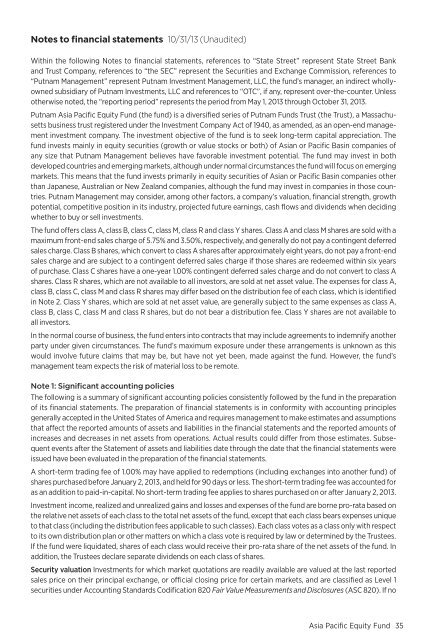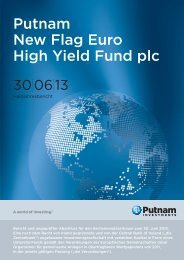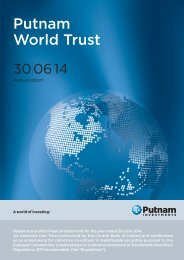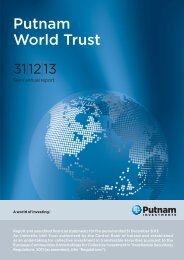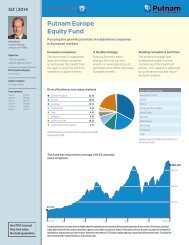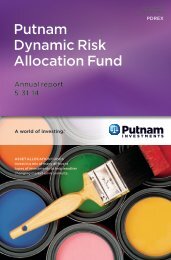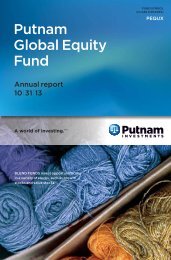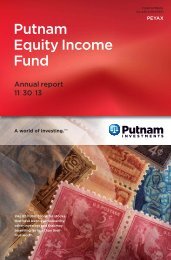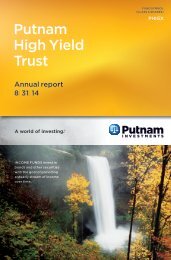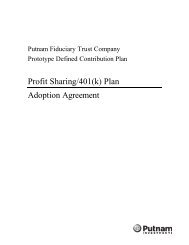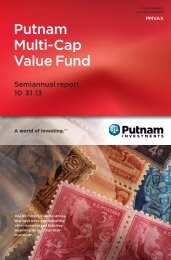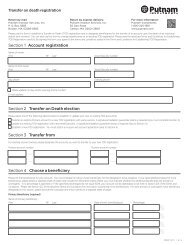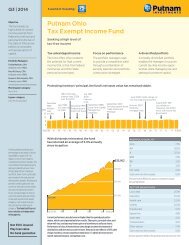Putnam Asia Pacific Equity Fund - Putnam Investments
Putnam Asia Pacific Equity Fund - Putnam Investments
Putnam Asia Pacific Equity Fund - Putnam Investments
- No tags were found...
Create successful ePaper yourself
Turn your PDF publications into a flip-book with our unique Google optimized e-Paper software.
Notes to financial statements 10/31/13 (Unaudited)<br />
Within the following Notes to financial statements, references to “State Street” represent State Street Bank<br />
and Trust Company, references to “the SEC” represent the Securities and Exchange Commission, references to<br />
“<strong>Putnam</strong> Management” represent <strong>Putnam</strong> Investment Management, LLC, the fund’s manager, an indirect whollyowned<br />
subsidiary of <strong>Putnam</strong> <strong>Investments</strong>, LLC and references to “OTC”, if any, represent over-the-counter. Unless<br />
otherwise noted, the “reporting period” represents the period from May 1, 2013 through October 31, 2013.<br />
<strong>Putnam</strong> <strong>Asia</strong> <strong>Pacific</strong> <strong>Equity</strong> <strong>Fund</strong> (the fund) is a diversified series of <strong>Putnam</strong> <strong>Fund</strong>s Trust (the Trust), a Massachusetts<br />
business trust registered under the Investment Company Act of 1940, as amended, as an open-end management<br />
investment company. The investment objective of the fund is to seek long-term capital appreciation. The<br />
fund invests mainly in equity securities (growth or value stocks or both) of <strong>Asia</strong>n or <strong>Pacific</strong> Basin companies of<br />
any size that <strong>Putnam</strong> Management believes have favorable investment potential. The fund may invest in both<br />
developed countries and emerging markets, although under normal circumstances the fund will focus on emerging<br />
markets. This means that the fund invests primarily in equity securities of <strong>Asia</strong>n or <strong>Pacific</strong> Basin companies other<br />
than Japanese, Australian or New Zealand companies, although the fund may invest in companies in those countries.<br />
<strong>Putnam</strong> Management may consider, among other factors, a company’s valuation, financial strength, growth<br />
potential, competitive position in its industry, projected future earnings, cash flows and dividends when deciding<br />
whether to buy or sell investments.<br />
The fund offers class A, class B, class C, class M, class R and class Y shares. Class A and class M shares are sold with a<br />
maximum front-end sales charge of 5.75% and 3.50%, respectively, and generally do not pay a contingent deferred<br />
sales charge. Class B shares, which convert to class A shares after approximately eight years, do not pay a front-end<br />
sales charge and are subject to a contingent deferred sales charge if those shares are redeemed within six years<br />
of purchase. Class C shares have a one-year 1.00% contingent deferred sales charge and do not convert to class A<br />
shares. Class R shares, which are not available to all investors, are sold at net asset value. The expenses for class A,<br />
class B, class C, class M and class R shares may differ based on the distribution fee of each class, which is identified<br />
in Note 2. Class Y shares, which are sold at net asset value, are generally subject to the same expenses as class A,<br />
class B, class C, class M and class R shares, but do not bear a distribution fee. Class Y shares are not available to<br />
all investors.<br />
In the normal course of business, the fund enters into contracts that may include agreements to indemnify another<br />
party under given circumstances. The fund’s maximum exposure under these arrangements is unknown as this<br />
would involve future claims that may be, but have not yet been, made against the fund. However, the fund’s<br />
management team expects the risk of material loss to be remote.<br />
Note 1: Significant accounting policies<br />
The following is a summary of significant accounting policies consistently followed by the fund in the preparation<br />
of its financial statements. The preparation of financial statements is in conformity with accounting principles<br />
generally accepted in the United States of America and requires management to make estimates and assumptions<br />
that affect the reported amounts of assets and liabilities in the financial statements and the reported amounts of<br />
increases and decreases in net assets from operations. Actual results could differ from those estimates. Subsequent<br />
events after the Statement of assets and liabilities date through the date that the financial statements were<br />
issued have been evaluated in the preparation of the financial statements.<br />
A short-term trading fee of 1.00% may have applied to redemptions (including exchanges into another fund) of<br />
shares purchased before January 2, 2013, and held for 90 days or less. The short-term trading fee was accounted for<br />
as an addition to paid-in-capital. No short-term trading fee applies to shares purchased on or after January 2, 2013.<br />
Investment income, realized and unrealized gains and losses and expenses of the fund are borne pro-rata based on<br />
the relative net assets of each class to the total net assets of the fund, except that each class bears expenses unique<br />
to that class (including the distribution fees applicable to such classes). Each class votes as a class only with respect<br />
to its own distribution plan or other matters on which a class vote is required by law or determined by the Trustees.<br />
If the fund were liquidated, shares of each class would receive their pro-rata share of the net assets of the fund. In<br />
addition, the Trustees declare separate dividends on each class of shares.<br />
Security valuation <strong>Investments</strong> for which market quotations are readily available are valued at the last reported<br />
sales price on their principal exchange, or official closing price for certain markets, and are classified as Level 1<br />
securities under Accounting Standards Codification 820 Fair Value Measurements and Disclosures (ASC 820). If no<br />
<strong>Asia</strong> <strong>Pacific</strong> <strong>Equity</strong> <strong>Fund</strong> 35


